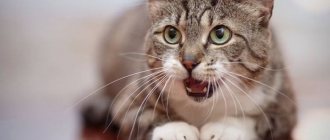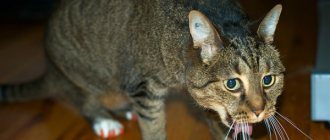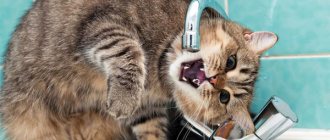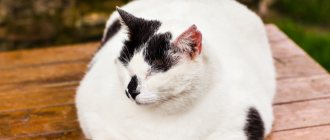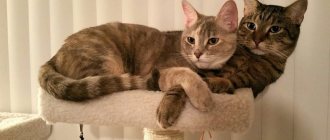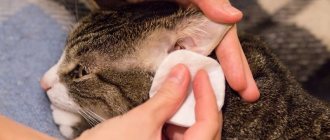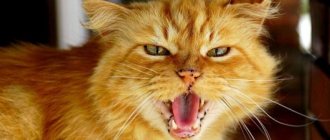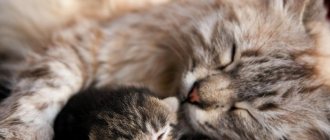Breathing is life. This is one of the reasons why cats and dogs with respiratory failure require quick and effective treatment. Experts at the Berloga veterinary clinic talk about what pulmonary failure is in animals, what symptoms it is accompanied by, and how therapy occurs.
Read in this article:
What is this?
Causes of pulmonary failure
How does DN manifest itself in cats and dogs?
When to ask for help?
How is respiratory failure treated in dogs and cats?
Initial stabilization
Diagnostics
Therapy
What is this?
Respiratory failure (RF) in dogs and cats is a pathological condition in which the animal’s lungs do not provide normal blood gas composition or do, but it is achieved due to the intensive work of the external respiratory apparatus and heart, which reduces the functional characteristics of the body.
Important! Pulmonary insufficiency in cats and dogs is dangerous because without timely treatment it leads to acute and chronic diseases of the bronchopulmonary system, circulatory disorders, damage to the central nervous system and a number of other dangerous complications.
Causes of pulmonary failure
Any disturbance in the functioning of one or more respiratory organs (for example, the respiratory tract or lungs) can lead to the development of respiratory failure in a cat or dog, which poses a direct threat to the health and life of the animal.
Respiratory failure occurs when the level of oxygen in the blood becomes too low (hypoxemic form) and when the level of carbon dioxide in the blood becomes too high (hypercapnic form).
Important! The causes of hypoxemic (pulmonary) and hypercapnic (ventilatory) forms of respiratory failure in dogs and cats differ.
Causes of hypercapnic (ventilation) form of respiratory failure:
- Violation of central regulation of breathing (control of respiratory muscles). Such disorders occur with arterial hypotension (low blood pressure), as well as with pathological processes occurring in the central nervous system (for example, meningoencephalitis), traumatic brain injury and poisoning with drugs that suppress the functioning of the respiratory center.
- Neuromuscular disorders. The main feature of such diseases is muscle weakness. Respiratory failure in cats and dogs can occur against the background of myopathy (chronic progressive neuromuscular diseases), as well as ruptures or unilateral persistent high position of the diaphragm, accompanied by damage to the phrenic nerve in animals.
- Damage to the chest and pleural cavity. The causes of respiratory failure in dogs and cats can be pneumothorax (accumulation of air or gases in the pleural cavity), floating rib fractures, neoplasms (malignant and benign tumors), as well as foreign objects trapped in the chest, and even metastatic pleurisy (inflammation of the pleura) .
- Airway obstruction. Respiratory failure in dogs and cats can be caused by bronchial asthma, laryngeal edema, as well as narrowing of the lumen of small bronchi and bronchioles (bronchospasm). These diseases impair the animal's airways, which can lead to the development of respiratory failure.
Causes of hypoxemic (pulmonary) respiratory failure, when the oxygen level in an animal's blood becomes too low, include pneumonia, acute respiratory distress syndrome, pulmonary edema, as well as lung injury in cats and dogs, pulmonary fibrosis, and pulmonary thromboembolism.
Why does the cat breathe quickly and stick out his tongue?
Everyone is familiar with the situation when a cat sticks out its tongue to wash itself or lap up milk. However, there are situations when you should worry about the condition of the animal.
First, let's look at situations where you don't need to worry:
- Forgetfulness. From time to time, cats forget themselves and go into the astral plane without hiding their tongue. Usually occurs after washing.
- Relaxation. All muscles relax during sleep; cats may develop a red stripe between their teeth. This is also the norm.
- Thermoregulation. During the heat, the cat may become hot; in order to relieve the situation, the cat sticks out its tongue, but this may indicate a possible heat stroke, so it is necessary to move the cat to a cool room and give it something to drink.
But if the cat breathes frequently, while opening its mouth, then you need to sound the alarm. The mechanism for the occurrence of problems in terms of breathing is quite simple: to improve gas exchange in the lungs and better supply of air there, the animal needs to breathe more often and deeper, which is why it has to open its mouth, stick out its tongue and lower it beyond the boundaries of the oral cavity. The cause can be a wide variety of diseases such as rhinitis, sinusitis, pulmonary inflammation and many other diseases.
And it is also important to note that the cause of this phenomenon is cardiovascular failure, poisoning and disorders in the brain. When poisoning occurs, vomiting occurs, the animal begins to cough, and as a result, all harmful substances leave the body. When disturbances occur in the brain, the cat is unable to control the movements of its body, including its tongue. Additionally, the cat may be accompanied by strabismus and other diseases.
How does DN manifest itself in cats and dogs?
Respiratory failure in cats and dogs occurs in acute or chronic form. In the first case, all symptoms rapidly increase within a few minutes or hours, and the condition itself poses a real threat to the life of the animal; in the second, all signs develop gradually.
The main signs of pulmonary failure in cats and dogs:
- apathy,
- decreased activity
- refusal of games and physical activity,
- loss of appetite,
- dyspnea,
- cyanosis of the mucous membranes of the oral cavity,
- rapid heartbeat (tachycardia),
- wheezing in the lung tissue (wheezing sounds when breathing),
- cough,
- shallow, asynchronous breathing,
- severe anxiety, anxiety.
Important! In severe forms of pulmonary failure in cats and dogs, white foam may be released from the mouth and nose, heart rhythm disturbances, hypoxemic coma and death may occur.
When to ask for help?
In case of acute respiratory failure, emergency veterinary care is important. Not only the health, but also the life of your pet depends on how quickly you contact a veterinarian in Moscow. If you notice increasing shortness of breath, coughing, wheezing, or difficulty breathing in a cat or dog, do not hesitate - make an appointment with a veterinarian.
Why does a cat wheeze when breathing?
Wheezing during breathing is not a disease, it is always a symptom of some kind of pathology. There are crepitating rales, blistering and dry. All of them are characteristic of certain diseases.
Crepitating wheezing, also known as crackling, accompanies pneumonia and atelectasis; bubbly, or wet, observed with bronchitis and pulmonary edema; dry wheezing is characteristic of diseases of bronchospasm and bronchitis. You can also distinguish a separate type of wheezing - the so-called whistling. It is usually observed when the glottis is paralyzed or foreign particles enter the trachea.
Sign up for a diagnosis of the causes of wheezing
How is respiratory failure treated in dogs and cats?
Treatment of pulmonary failure in animals is a complex process. It includes several stages, the first is stabilization of the patient’s condition, the second is diagnosis, the third is direct treatment of respiratory failure. To make it more convenient for you to understand how treatment occurs, let’s talk separately about each of these stages.
Initial stabilization
It is necessary to stabilize the animal’s condition, prevent the development of complications and give the veterinarian time to diagnose. Initial stabilization usually includes:
- Oxygen therapy. It is performed with or without sedation. The most common approach is to use an oxygen cage with a high proportion of inspired oxygen (eg, 40-60%). Additionally, the veterinarian may use a face mask or oxygen hose. In extreme cases, cats and dogs require emergency intubation as well as a higher proportion of inspired oxygen (eg, 100%).
- Sedation. It is used in conjunction with intubation and ventilation if the pet is experiencing severe anxiety. Some animals, particularly dogs with upper airway obstruction, require stabilization with special sedatives. After their introduction, the veterinarian clears the animal's mouth of any obstructing material (for example, secretions), and then performs intubation or tracheostomy.
- Decrease in temperature. An increased respiratory rate often leads to hyperthermia, so cooling the animal is one of the stages of initial stabilization. To do this, cover the cat or dog with damp towels, use fans, and apply alcohol to the armpits, groin area, and feet. The decrease in temperature stops as soon as the temperature reaches 38 ° C in order to prevent the opposite effect - hypothermia.
Diagnostics
To make an accurate diagnosis, doctors at a veterinary clinic in Moscow assess whether the pet has a natural predisposition to upper respiratory tract obstruction (for example, English bulldogs have a predisposition to brachycephalic respiratory tract diseases), cardiogenic pulmonary edema, as well as lower respiratory tract obstruction caused by asthma.
The next stage of diagnosis is collecting an anamnesis. The doctor asks several questions of the pet owner to determine possible causes of pulmonary insufficiency (for example, blunt trauma to the dog reported by the owner may cause pulmonary contusions or pneumothorax, which are symptoms of pulmonary insufficiency).
Next, a clinical examination is carried out, and after the cat or dog’s condition is restored, an extensive diagnosis is carried out:
- blood analysis,
- Ultrasound, CT scan of the chest,
- echocardiography (ECG),
- respiratory tract examination,
- respiratory fluid analysis.
Therapy
Treatment depends on the diagnosis, which determines the cause of chronic or acute respiratory failure in cats and dogs. For example, if it is caused by lower airway obstruction due to mucus buildup or bronchial inflammation, treatment would include bronchodilators and corticosteroids and, if necessary, deworming.
If respiratory failure is caused by pneumonia, pulmonary edema or other pulmonary parenchymal diseases, treatment involves the use of broad-spectrum antibiotics. If the cause is pulmonary thromboembolism, then therapy includes taking anticoagulants and antiplatelet agents.
Remember that effective treatment of pulmonary insufficiency in cats and dogs is only possible with timely access to a veterinary clinic. The specialist will urgently take measures for initial stabilization, accurate diagnosis and treatment, the methods of which directly depend on the cause of respiratory failure.
What examinations will be required?
To understand what causes rapid breathing in a cat, the veterinarian will question the owner in detail about when and under what circumstances the symptom appeared, what the animal ate the day before, whether it could have been poisoned, etc. Next, he will conduct a visual examination with palpation and, most likely, will refer you for tests.
In most cases, you have to donate blood and undergo ultrasound diagnostics. Sometimes an x-ray is required. These methods will help you find out why your cat is breathing frequently and prescribe adequate treatment.
When you look at how much your pet’s stomach swells and how often he gasps for air, it becomes truly scary. After all, breathing problems are a direct threat to life. However, there is no need to panic, although you also cannot waste time - you cannot get it back. If the condition worsens sharply, it will be more difficult to help the cat.
You should show the animal to a doctor as soon as possible and find out why it is breathing incorrectly. In the vast majority of cases, the diseases are not fatal and respond well to treatment.
When you look at how much your pet’s stomach swells and how often he gasps for air, it becomes truly scary. After all, breathing problems are a direct threat to life. However, there is no need to panic, although you also cannot waste time - you cannot get it back. If the condition worsens sharply, it will be more difficult to help the cat.
